Over the past week, I started looking into invasive aquatic plants, focusing largely on which species seem most worrisome, how they are being moved around, and how they may impact the ecosystems they invade. After a little searching, I started to see patterns with regard to names and means of transport, but I also started to see different interpretations of invasive species ecosystem roles, which suggests that there is still a lot to learn about this vegetation. What was clear is that this is a global issue, both in terms of source populations and destinations.
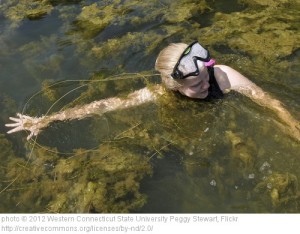
Lovely milfoil!
What species are the worst offenders? That’s a pretty complicated question since it requires defining what a ‘significant impact’ is, as well as categorizing good and bad. Additionally, these invasive species all came from some place, so they are native flora in someone’s backyard. However, there were a few names that kept coming up again and again in variety of places: Spartina alterniflora (a type of marsh grass), Caulerpa taxifolia (popular in aquaria), Hydrilla verticillata, Eichhornia crassipes (water hyacinth), Ipomoea aquatic (Chinese water spinach), Myriophyllum spicatum (European milfoil). Records for these species as invaders span the globe and a variety of water habitats. Some are an issue in coastal wetlands and in marine ecosystems (like Spartina and Caulerpa) while others are found in freshwater systems. The US, IUCN, other countries, and individual states have lists of invasive vegetation in case you want to see what’s a real issue where you are (and what you’re not supposed to be growing…)- what was very interesting to me was looking through the US Federal List of Noxious Weeds and then searching the internet for vendors- some of these are unnervingly easy to find and don’t mention their status as invasives (in fact, I found detailed instructions on how to take very good care of water hyacinth).
Exactly what is it that makes them so scary? Well, it depends on the species, but some of them have the real capacity to modify the environments around them, and that can be a problem for native flora and fauna, as well as for humans. Water hyacinth and hydilla are on Florida’s list of “most invasive” plants because they tend to reduce surface water flow and dissolved oxygen in the water, so they cause more sediment to settle which can fill channels and canals, and hydrilla can outcompete native eelgrass and alter the vegetation available to native fish and invertebrates (Gordon 1998). Milfoil was found to suppress and displace native plants from deeper water in New York’s Finger Lakes region (Madsen et al. 2008) and was linked to loss of habitat for larger fish in lakes in California and Nevada (Eiswerth et al. 2000). Spartina can trap sediment, changing west coast mud flats to raised marshes, and yet there are real concerns along the east coast about loss of native spartina as phragmites reeds spread. So, even the location is important to determining invader impact. And lest you think that the invasions are in one direction, in China fanwort from eastern North America is a problem (Zhang et al. 2003), and the Senegal delta in Africa has seen changes in water flow, sedimentation, and fauna with the presence of water hyacinth, water spinach, and other invasives (Fall et al. 2004). Having said all of this, there is still debate about whether invasive species are automatically bad and whether they can suitably fill ecosystem roles in their new habitat (Capers et al. 2007; Madsen et al. 2008; Mueller & Hellmann 2008). In some areas, invasives create a monoculture which negatively impacts native flora and fauna, in others invasives improve water quality. And how do you address an invasive which may be threatened in its native range? These situations can get pretty complicated.
How are these aquatic invaders moving around? We can take a lot of credit for this- we’re doing a pretty good job of providing transportation. In some cases, we’ve deliberately introduced nonnative species, such as the tomatoes which are now such a staple of Italian cooking (and originally from the Americas) or the chickens whose eggs I used for baking a few days ago (origin in southeast Asia) and sometimes these species get out from under our control- in the case of aquatic plants, that could be as a result of spreading aquaculture or even heavy rains which caused your pond to overflow into a nearby stream. We’ve also carried species unintentionally during the course of international trade, for example in the dirt and water ballasts of ships (which is one reason to have ships discharge ballast water mid-ocean and then take on fresh water for the remainder of the journey, although it’s not a complete solution), or even on planes (brown tree snake meet vulnerable Guam bird species, Guam bird species meet bad news…). And then there at the introductions done intentionally but without really thinking about it– Caulerpa and other species found in home aquaria tend to be released into the wild when people get tired of caring for pet fish and decide to liberate them- since the individuals in aquaria are more likely to be larger, mature specimens with the capacity for reproduction, versus those in ballast water, they already have a head start (Padilla & Williams 2004).

Water hyacinth control keeps the Nile flowing and available to animals and people
So we know that there are a variety of invasive species which are turning up in aquatic habitats across the globe, sometimes with very negative consequences for both native species and people (before control efforts, water hyacinth was using 10% of the Nile’s water (Padilla & Williams 2004)- that’s a pretty big deal). And we are largely responsible, whether we mean to or not, for the access these invasives have to new opportunities. For my next post, I’ll try to get a handle on how we’re trying to control and/or remove invasives and what concerns there are for the future given climate change predictions. My guess is it’s bound to get even messier.
Works cited:
Capers, RS, Selsky, R, Bugbee, GJ and JC White. 2007. Aquatic plant community invisibility and scale-dependent patterns in native and invasive species richness. Ecology 88: 3135-3143.
Eiswerth, ME, Donaldson, SG, and WS Johnson. 2000. Potential environmental impacts and economic damages of Eurasian watermilfoil (Myriophyllum spicatum) in western Nevada and northeastern California. Weed Technology 14: 511-518.
Fall, O, Fall, I and N Hori. 2004. Assessment of the abundance and distribution of the aquatic plants and their impacts in the Senegal River delta: the case of Khouma and Djoudj streams. Weed Technology 18: 1203-1209.
Gordon, DR. 1998. Effects of invasive, non-indigenous plant species on ecosystem processes: lessons from Florida. Ecological Applications 8: 975-989.
Madsen, JD, Stewart, RM, Getsinger, KD, Johnson, RL, and RM Wersal. 2008. Aquatic plant communities in Waneta Lake and Lamoka Lake, New York. Northeastern Naturalist 15: 97-110.
Mueller, JM and JJ Hellmann. 2008. An assessment of invasion risk from assisted migration. Conservation Biology 22: 562-567.
Padilla, DK and SL Williams. 2004. Beyond ballast water: aquarium and ornamental trades as sources of invasive species in aquatic ecosystems. Frontiers in Ecology and the Environment 2: 131-138.
Zhang, X, Zhong, Y and J Chen. 2003. Fanwort in eastern China: an invasive aquatic plant and potential ecological consequences. Ambio 32: 158-159.
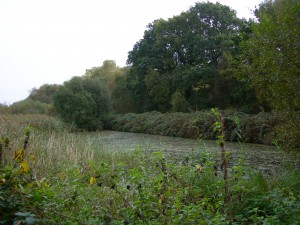
How much of this vegetation is native and how much is not?
I’ve spent a good chunk of my time over the past few months on the coast of Louisiana, mainly on the barrier islands, but I also get to see a lot of marsh on the boat ride out. I also survey a lot of swamp on the drive to and from our launch point, so I spend a large portion of my week looking at green vegetation. And it always amazes me how different the wetlands here are from those in New England, as well as any other wetlands I’ve visited. The same is true for any of the lakes and rivers I’ve jumped into, whether in Europe or the American southwest- so it makes sense that the wildlife and vegetation in each place is a distinct community. But I know that there are real concerns about invasive species around the world, and we’re in danger of homogenizing the diversity out there. Since a look at all invasive species everywhere is far too big a task for one month, I’m going to focus on freshwater and marine invasive plants. It seems both relevant in a conservation context and as we move toward summer activities in the northern hemisphere.
I know a bit about some aquatic invasives- for example, I know that there are restoration efforts in New England to remove phragmites reeds, sometimes by fire, so that native vegetation, such as grasses and cattails, can retake the area- muskrat, and other wildlife species, prefer cattails to phragmites, so restoration is helpful for them as well. I know that milfoil is something you are supposed to look for when you take your boat out of the water for transport to another location- sometimes boats help move plant pieces from lake to lake, facilitating the spread of a species that can choke out native vegetation. And I know a bit about Caulerpa spp. of algae which have created problems in the Mediterranean and been eradicated from San Francisco Bay after several years and several million dollars.
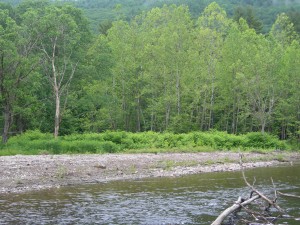
Japanese knotweed is a problem along this river bank in NH
Invasives are a big deal and we tend to provide the highways of invasion. But we can also provide the frontline for resistance and native species conservation. This month I’ll be looking into past and current invasions of aquatic vegetation species, as well as efforts to minimize their spread and impact. In some cases, we may simply have to deal with their presence, but in others hopefully there are ways we can get involved in monitoring and removing non-native threats to native biodiversity. If you enjoy spending time on the water as much as I do, I think it makes sense to be aware how those ecosystems are changing and the role invasive species play in that change. I also think we have a responsibility to be active and give back to the areas we enjoy so much.
In my last few posts, I’ve talked about species whose international trade was regulated on a global level, with varying degrees of control and success. To finish out this month, I want to discuss one further level of CITES that makes conservation both more individual and complicated. In addition to Appendices I and II, CITES also contains Appendix III which lists species for which international trade is regulated only with certain countries. To get on Appendix III, a country simply has to inform CITES that it is listing a species- all international trade of that species in the future will need export permits when sourced from the listing country, but not other countries. A country might choose to list a species because, although the global population is relatively stable, there are concerns over its domestic population; or a country may have been trying to get the species listed on Appendix II without getting enough support from other countries and this at least gives the species a little protection. As I mentioned in my last post, big-leaf mahogany was first listed by individual countries on Appendix III and then moved to Appendix II when the decision was made that more over-sight was needed.

Naultinus spp.
What kinds of species get on Appendix III? In the case of big-leaf mahogany, there was concern that demand was so strong as to create massive black market trade that could destroy local populations and specific countries were responding to internal concerns over illegal harvest and overexploitation (Grogan & Barreto 2005). In other cases it may be an endemic species that is found nowhere else in the world, so only the source-country is able to monitor the wild population. One example of this is the genus Colophon in South Africa- this includes 14 species of Cape stag beetle with limited distribution in South Africa. Currently we have limited knowledge of the genus’ ecology, but they are targets for collectors and there are concerns that illegal trade of these insects puts the long-term survival of these species in jeopardy (www.iucnredlist.org). New Zealand listed all native gecko species on Appendix III because a variety of circumstances has put both Naultinus spp. and Haplodactylus spp. at risk (www.doc.govt.nz/conservation). According to a story in the New Zealand Herald (Fox 2013), green geckos (Naultinus spp.) are especially sought by collectors and 24 specimens have been recovered from smugglers since 2010. Geckos in New Zealand are also threatened by introduced mammalian predators and habitat loss, and, since they are slow to reproduce [giving birth to an average of 1-2 live young per brood (Hare & Cree 2005)], these populations are vulnerable to increased predation and human influence.
What part can we play with Appendix III species? I think the big message here is, once again, being aware of where plants and animals, and their products, are coming from- if we aren’t educated consumers, it’s more difficult to persuade suppliers to follow the rules. Although this is not true of all Appendix III species, I did notice that quite a few are involved in the pet trade- if you plan on acquiring animals as pets, do a little research on the species you are interested in and make sure there are no trade restrictions (cites.org has a good list) and ask suppliers where they source their animals and plants. According to Gerson et al. (2008), more than half of Canadian importers bringing in amphibians, plants, invertebrates, and fish for aquariums simply listed the whole shipment as ornamental fish if fish made up the bulk of the group- that makes it pretty hard to keep track of provenance, so I think we have to be more vocal about wanting accurate information. It’s probably also a good idea to take a look at the Appendix III species for our own countries, so that we can be a bit more informed about what is going on in our own backyards.
Over the past few weeks, I’ve tried to provide a sense of the current structure for international regulation of trade in flora and fauna because I think that it’s important we all know how the process works. I think it’s also important that we understand how much our own interest in specific species can help support or undermine these efforts. As the ultimate purchasers of plants, animals, and their products, we have a responsibility to not only think about how our decisions impact wild populations but also push suppliers to comply with the regulations that are in place. The globe is a hard place to police, so we all have to chip in and help a little.
Works cited:
Fox, R. 2013. Greater protection sough for geckos. New Zealand Herald: 03/10/2013.
Gerson, H, Cudmore, B, Mandrak, NE, Coote, LD, Farr, K and G Baillargeon. 2008. Monitoring international wildlife trade with coded species data. Conservation Biology 22: 4-7.
Grogan, J. and P. Barreto. 2005. Big-leaf mahogany on CITES Appendix II: big challenge, big opportunity. Conservation Biology 19: 973-976.
Hare, KM and A Cree. 2005. Natural history of Hoplodactylus stephensi (Reptilia: Gekkonidae) on Stephens Island, Cook Strait, New Zealand. New Zealand Journal of Ecology 29: 137-142.
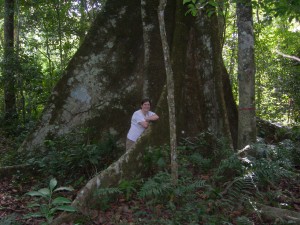
Just imagine if this fell!
Is there any way to be certain that it was cut legally? In many ways, that is the challenge for sustainable management of timber, especially in tropical locations. If you have seen this month’s edition of ‘National Geographic,’ you will already have a sense of just difficult it can be to monitor and enforce national and international timber-harvest protocol. Appendix II of CITES is designed to permit international trade in species, provided it does not work against species survival, but how do you promote sustainable use and prevent exploitation?
Species listed on Appendix II require an export permit which is issued after authorities in the exporting country have found that the trade does not negatively impact the survival of the species or its ability to fulfill ecosystem roles. In addition, the specimen must be legally obtained and appropriate arrangements for transport must have been made. Part of the goal here is to control use of the species so that it is sustainable in the long-run. It is also hoped that prices paid by the market will provide incentive for people to pursue legal trade. Does this method work? Well, it appears to depend, in part, on the species. As I mentioned in my last post, as long as there is enough demand, black markets will seek to profit. And one of the biggest questions facing any type of regulated harvest is “What is sustainable?” How do we know where the line between sustainable and degrading is? And how do captive breeding programs play into international trade? Luiselli et al. (2012) looked at the international python trade sourced out of Africa and Asia- because the predominant use for snakes differed between the two regions, there were different impacts on wild populations and habitat. Because pythons coming out of Africa were largely destined for the pet trade and a large part of the demand could be met by snake ranching, the level of trade had been apparently sustainable for 35 years and had even promoted habitat protection. In contrast, since most pythons from Asia are used for their skins, ranching does not provide an adequate economic return and most snakes are wild-caught, putting massive pressure on the populations.
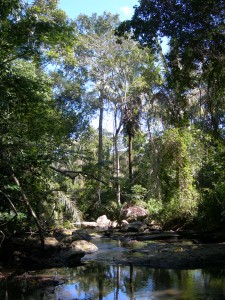
How many different tree species do you see in this picture?
What about when the trade involves trees? One of the big issues here is making sure that illegally harvested trees aren’t laundered for entry into the international market. This is mentioned in the National Geographic article about mahogany, and it’s an issue that has faced a variety of timber-source countries. Starting in 1995, countries in the Neotropics began listing big-leaf mahogany individually in an attempt to separate legal from illegal harvest (Grogan & Barreto 2005); by 2000 Costa Rica, Bolivia, Brazil, Columbia, Mexico, and Peru had all put the tree on their individual Appendix III lists (which means that any mahogany coming from them should have an export permit). When Brazil banned mahogany harvesting in 2001 in response to fraud within the system, illegal logging in Peru increased to meet demand. Because illegally-sourced mahogany continued to enter the market despite multiple Appendix III listings, mahogany was officially listed in Appendix II in 2003. Even with Appendix II listing, there continue to be problems with illegal logging and trade of mahogany (Tomaselli & Hirakuri 2008). Does this mean that allowing regulated trade is ineffective? Not really, although it means that there are still loopholes the black market can exploit. Partly as a result of a 2006 Free-Trade Agreement that the US signed with Peru, the Peruvian government instituted a new Forest Law in 2008 and worked to enact stricter controls for timber harvest (Tomaselli & Hirakuri 2008). Since the US consumes around 80% of mahogany exports (Blundell 2007), buyers here have both substantial power in effecting change and considerable responsibility to make good source decisions.
What can people outside of the source-nations do to ensure international trade is legitimate? The most important thing is to pay attention to where products, plants, and animals come from– this means asking lots of questions, but that is sometimes the only way to convey how important that information is to you. Typically, if someone can tell you the source of the fish or orchid or plywood, it’s because that information is important to them and they are hoping you will ask. If they can’t answer your questions, that may be an important sign as well. Obviously, it can be difficult to trace every animal or plant product, but it’s important to try, and there are several systems in place to help facilitate communication- FSC certification for wood products is a good sign, and some harvesters are focusing on what is called ‘chain-of-custody’ tracking for individual logs so that a clear record for how and where each was harvested and processed exists. (And if you would like to get regular updates about the tropical timber industry, you can sign up for ITTO’s newsletter.) When it comes to the pet trade, ask the vendor where the animals came from and do your own research on the status of wild populations for the species. Animal breeders who are committed to the species and breeds they work with tend to have records that go back generations. And it’s important to be a good market for sustainable plant and animal harvests– it may take a bit more effort to find sustainable sources, and it may mean considering alternative species (for example, a tropical tree species that is less well-known), but often the only way to convince suppliers to continue with sustainable efforts is to provide a responsive and rewarding market. So we all have a part to play in the global plant and animal trade.
Works cited:
Blundell, AG. 2007. Implementing CITES regulations for timber. Ecological Applications 17: 323-330.
Grogan, J. and P. Barreto. 2005. Big-leaf mahogany on CITES Appendix II: big challenge, big opportunity. Conservation Biology 19: 973-976.
Luiselli, L., Bonnet, X., Rocco, M. and G. Amori. 2012. Conservation implications of rapid shifts in the trade of wild African and Asian pythons. Biotropica 44: 569-573.
Tomaselli, I. and SR. Hirakuri. 2008. Converting mahogany. ITTO Tropical Forest Update 18: 12-15.
As I mentioned in my last post, species listed on Appendix I of CITES are not permitted in international commercial trade. These are species which are threatened with extinction if trade continues. Trade is allowed only for non-commercial use and under exceptional circumstances. In order for the specimen to be transported internationally, first an import permit must be issued which guarantees that A) the specimen is destined only for non-commercial use, B) the future use is not detrimental to the survival of the species, and C) if it’s a live animal (CITES covers animal products as well as living individuals), the proposed new caretakers can provide adequate care. Once the import permit is issued, an export permit must then be issued to ensure that the specimen was legally obtained, such international trade is not detrimental to the survival of the species, and, in the case of a live animal, adequate travel preparations have been made. Why require two separate permits? The goal here is extra oversight- if customs is checking paperwork both at exit and entry, hopefully there is a better chance of catching illegal trade, plus two separate authorities have to determine that the trade would not be detrimental to the survival of the species.
Does a ban on commercial trade help species rebound? That is the big question, on many levels. Some species and populations have been downgraded from Appendix I to Appendix II- in 2004, for example, the bald eagle as a whole was downlisted, as was the Cuban population of American crocodiles. Many other species, however, have been placed on Appendix I and remain there. Does this mean that Appendix I doesn’t work? No, although it means there are a variety of obstacles which hamper the positive impacts of a trade ban. In earlier posts I have provided commentary on current levels of ivory poaching, so I’m not going to re-open the elephant discussion (although that situation remains as dark as it was a few months ago)- instead I want to focus on tigers as an example of how CITES is important for conservation, but is not a panacea for endangered species. I truly believe that a trade ban is necessary in the case of tigers, but I don’t think it’s enough.
 What’s the deal with tigers? The last several hundred years have seen a dramatic decline in all tiger subspecies (and we lost 2)- today tigers occupy about 7% of their original range and the wild population is estimated between 3400 and 5150 animals (Kirkpatrick & Emerton 2010). The bulk of that, as well as most of the protected areas and larger ‘source’ populations, are found in India (Seidensticker 2010). Tigers are listed in Appendix I (in fact, all of the felids, with the exception of the house cat, are in either I or II) which means there is a complete trade ban. Is this helping? Not enough, but for several very different reasons. As Damania et al. (2003) pointed out, tigers continue to be hunted and traded specifically because there is a still a market for tiger products. Because tiger products are in demand for medicinal uses and status symbols, among other things, poaching continues despite the trade ban. Between 1970 and 1993, over 3990 kilograms of illegal bones were transported from Indonesia to South Korea (Wibisono & Pusparini 2010). As long as there is demand coupled with economic incentive, someone will step in to fill the void- in the case of tigers, it is felt that, while local hunters are the ones actually killing the tigers, well-financed international cartels control the black market trade. Damania et al. (2003) suggested that making poaching itself more costly, in the form of larger fines, jail sentences, etc., could help dissuade local hunters, although that doesn’t address how to give people economic alternatives to poaching in the first place. A more global effort is needed to end illegal international trade. Apart from the poaching of tigers, there are also concerns about poaching of the prey tigers need to survive, sometimes for human consumption and sometimes in retaliation for eating a farmer’s crop. Without an adequate prey base, tigers are condemned to further conflict with humans and population decline. Finally, a trade ban doesn’t deal with one of the biggest issues facing tigers: habitat loss. With growing human populations throughout the tiger’s range and greater human exploitation of natural resources, even if tigers weren’t being hunted for illegal trade, they would still be facing massive challenges. Does that mean CITES can’t help? Absolutely not- even with more prey and larger reserves, tiger populations are believed to be able to sustain at most 15% annual mortality (Seidensticker 2010)- poaching-related deaths alone in the Russian Far East between 1992 and 2002 amounted to a 20% annual mortality rate (Kirkpatrick & Emerton 2010). So tigers need protection from poaching, but they also need larger, more connected reserves, and a protected prey base.
What’s the deal with tigers? The last several hundred years have seen a dramatic decline in all tiger subspecies (and we lost 2)- today tigers occupy about 7% of their original range and the wild population is estimated between 3400 and 5150 animals (Kirkpatrick & Emerton 2010). The bulk of that, as well as most of the protected areas and larger ‘source’ populations, are found in India (Seidensticker 2010). Tigers are listed in Appendix I (in fact, all of the felids, with the exception of the house cat, are in either I or II) which means there is a complete trade ban. Is this helping? Not enough, but for several very different reasons. As Damania et al. (2003) pointed out, tigers continue to be hunted and traded specifically because there is a still a market for tiger products. Because tiger products are in demand for medicinal uses and status symbols, among other things, poaching continues despite the trade ban. Between 1970 and 1993, over 3990 kilograms of illegal bones were transported from Indonesia to South Korea (Wibisono & Pusparini 2010). As long as there is demand coupled with economic incentive, someone will step in to fill the void- in the case of tigers, it is felt that, while local hunters are the ones actually killing the tigers, well-financed international cartels control the black market trade. Damania et al. (2003) suggested that making poaching itself more costly, in the form of larger fines, jail sentences, etc., could help dissuade local hunters, although that doesn’t address how to give people economic alternatives to poaching in the first place. A more global effort is needed to end illegal international trade. Apart from the poaching of tigers, there are also concerns about poaching of the prey tigers need to survive, sometimes for human consumption and sometimes in retaliation for eating a farmer’s crop. Without an adequate prey base, tigers are condemned to further conflict with humans and population decline. Finally, a trade ban doesn’t deal with one of the biggest issues facing tigers: habitat loss. With growing human populations throughout the tiger’s range and greater human exploitation of natural resources, even if tigers weren’t being hunted for illegal trade, they would still be facing massive challenges. Does that mean CITES can’t help? Absolutely not- even with more prey and larger reserves, tiger populations are believed to be able to sustain at most 15% annual mortality (Seidensticker 2010)- poaching-related deaths alone in the Russian Far East between 1992 and 2002 amounted to a 20% annual mortality rate (Kirkpatrick & Emerton 2010). So tigers need protection from poaching, but they also need larger, more connected reserves, and a protected prey base.
What can we do to help? There are a number of ways to better protect tigers at many different conservation levels in addition to abstaining from use of tiger products:
- Tigers need access to more protected habitat and to corridors between protected areas; at the same time local people need to feel that they benefit economically from the presence of living tigers. Generally people outside of Asia can contribute to these goals largely through donations, although travelling to tiger countries, if that’s an option, is another way of showing that living tigers have value. There are a number of conservation organizations with tiger-focused programs, including WWF, Panthera, and the Wildlife Conservation Society.
- In terms of global cooperation, the CITES Secretariat needs to have the resources and authority to address illegal trading networks- that kind of support comes from signatory nations, and quite a few, including the US and many European nations, provide direct funding, training, and information for halting illegal trade in endangered species. But that support is in some ways contingent upon citizens of those countries making it clear that regulation of this trade is important to them- so be sure to communicate your concerns to your elected officials. There are also ways the international community can provide incentives for tiger habitat protection- according to Wikramanayake et al. (2011), protected landscapes with tigers have several times the carbon density of landscapes around the protected areas- they could be used in carbon trading programs, thereby protecting tigers and providing an economic boost to the country itself.
- Even in our daily lives we can make choices that help tigers- Save Tigers Now advocates using recycled and FSC-certified wood products to ensure that the resources you use are harvested sustainably. The same applies to shade-grown coffee.
- The Wildlife Conservation Society also has a program to support and train Russian students for tiger research and conservation- I think this is a fantastic idea because the goal is that communities and nations have committed conservationists with the knowledge and skills they need to be effective in their own landscapes- although it is not directly mentioned on their website, I imagine that WCS can use support in these efforts as well, and I think it would be great if people could sponsor students and local community members in terms of training and tiger-friendly economic development.
So there are ways to help support tiger populations, some of which are directly related to the intent of Appendix I and some of which are outside of that arena. Put together, those efforts can really make a difference for a species that is threatened by human exploitation on multiple levels. I encourage you to take a look at the list of Appendix I, II, and III species to get a better sense of which trades are regulated and brainstorm ways to support CITES. In my next post, I’ll look at species with allowed but regulated international trade.
Works cited:
Damania, R, Stringer, R, Karanth, KU and B Stith. 2003. The economics of protecting tiger populations: linking household behavior to poaching and prey depletion. Land Economics 79: 198-216.
Kirkpatrick, RC and L Emerton. 2010. Killing tigers to save them: fallacies of the farming argument. Conservation Biology 24: 655-659.
Seidensticker, J. 2010. Saving wild tigers: a case study in biodiversity loss and challenges to be met for recovery beyond 2010. Integrative Zoology 5: 285-299.
Wibisono, HT and W Pusparini. 2010. Sumatran tiger (Panthera tigris sumatrae): a review of conservation status. Integrative Zoology 5: 313-323.
Wikramanayake, E, Dinerstein, E, Seidensticker, J, Lumpkin, S, Pandav, B, Shrestha, M, Mishra, H, Ballou, J, Johnsingh, AJT, Chestin, I, sunarto, S, Thinley, P, Thapa, K, Jiang, G, Elagupillay, S, Kafley, H, Man Babu Pradhan, N, Jigme, K, Teak, S, Cutter, P, Abdul Aziz, Md, and U Than. 2011. A landscape-based conservation strategy to double the wild tiger population. Conservation Letters 4: 219-227.
It’s always nice to take a break from the usual routine- a small diversion can provide amusement, a new viewpoint, or just a chance to try something new. This month, I’ve decided to step away from the usual format and go with four posts which provide mainly information about three different elements of one larger issue: CITES. As some of you may know, mid-March witnessed the 16th meeting for countries involved in the Convention on International Trade in Endangered Species (this year is also the 40th anniversary of the original signing of the convention), and I was rather impressed with some of the decisions made at this year’s meeting (although a little disappointed with others). Rather than provide an end-of-month summary about the issue, I’m going to include suggestions for how to learn more and get involved in each post. I think it is important that we all understand what this convention regulates, how it works, and what we can do to support regulation of trade in flora and fauna.
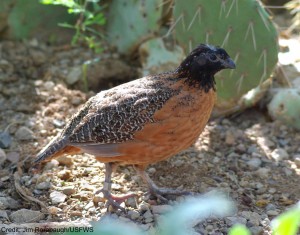
Did you know that a subspecies of northern bobwhite, the masked bobwhite, is listed in Appendix I? The species disappeared from the US and has since been reintroduced in Arizona, but there are still only a few hundred birds here.
CITES was first signed in 1973 in response to the recognition that international trade in some endangered species was adversely affecting conservation efforts. The goal of this global agreement (177 signatories and counting) is to regulate trade in such a way that unsustainable use is avoided and no species are driven to extinction though exploitative trade by humans. There are quite a few discussions about the effectiveness of the convention as well as its jurisdiction, all of which I will address later, but first I want to give you background on the convention’s structure and how species get on the list.
There are three Appendices which describe the different levels of regulation: Appendix I includes species for which only non-commercial trade is allowed under special circumstances, and such trade requires both a permit from the exporting country and a permit from the importing country. Currently there are about 530 animal and 300 plant species in Appendix I, and these species have typically seen a large reduction in population size, such as elephants and tigers. Appendix II includes the bulk of CITES-listed species (over 4,460 animal species and 28,000 plant species) and these species are felt to be at risk from meeting Appendix I criteria if trade is not regulated. These species can be commercially traded, however, permits are required from exporting countries. Appendix III includes species that specific countries list as requiring export permits from that country- the idea here is that countries which are concerned about the status of a nationally-protected species can ask other countries to make sure any exports from the listing country have the proper approval; if the species comes from a non-listing country, no permit is required. There are over 290 species in Appendix III.
In order to get listed in Appendices I and II, a two-thirds majority vote by countries at a conference is needed. Countries can opt to take a ‘reservation’ which exempts them from the requirements for a specific listed species (this can undermine the impact of CITES). To list a species on Appendix III, a country must simply already have national protection for that species and then inform the CITES Secretariat of the decision. Species can also be moved between Appendices and removed from listing if that is deemed appropriate. There are provisions for penalizing countries which do not abide by regulations, and much of the pressure to follow CITES guidelines comes from the international community in the form of incentives, embargoes, etc.
So the idea is oversight of global trade in vulnerable species to prevent species loss. One interesting comment I saw about the effectiveness of CITES is that there appear to be two different approaches to the program: one group of countries sees CITES as a means to regulate trade so that it is sustainable over the long-term, and the other group sees CITES as a final option in the face of extinction (Sky 2010). If species aren’t listed until their populations are already in massive decline, their chances of recovery and allowing for sustainable harvest are probably worse than if the species is listed when trade is picking up but the population remains at more than 20% of the original baseline.
I highly recommend that you take a look at the CITES website which has information on the recent meeting as well as specific programs. You can look at the status of listed species, as well as which species have been listed by your country. The global and national trade dashboards can give you a picture of trade trends over time (the global bird trade was particularly scary). I think that people tend to remember ivory and rhino horn when they hear about trade in endangered species, and they don’t always know about the smaller, less charismatic species which are at risk- looking through the information on CITES listings is a good place to get a more global view. Over the next few weeks, I’ll be looking into each Appendix in turn and some of the listed species, but you may want to do a little investigation on your own.
Works cited:
Sky, MB. 2010. Getting on the list: politics and procedural maneuvering in CITES Appendix I and II for commercially exploited marine and timber species. Sustainable Development Law & Policy Spring: 35-55.
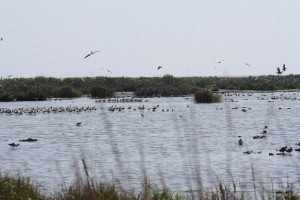 Many of the salt marsh and barrier island restoration projects I’ve described in previous posts are pretty big scale- it would be challenging for an individual to plan and carry out offshore dredging or large-scale marsh terrace construction. But is there a way to contribute in some small fashion to these bigger projects? Given how important these areas are to coastal populations, it would be only right, I think, for those of us living under their protection to give back in some way. And there must be options for smaller scale restoration as well.
Many of the salt marsh and barrier island restoration projects I’ve described in previous posts are pretty big scale- it would be challenging for an individual to plan and carry out offshore dredging or large-scale marsh terrace construction. But is there a way to contribute in some small fashion to these bigger projects? Given how important these areas are to coastal populations, it would be only right, I think, for those of us living under their protection to give back in some way. And there must be options for smaller scale restoration as well.
As I searched for opportunities to contribute to salt marsh and barrier island restoration, it became very clear that current efforts are largely on a watershed-by-watershed basis- concerned community members, governmental officials, and scientists had organized themselves to investigate and address their own concerns. I think this is fantastic on several levels: first, the status reports for projects that have been initiated suggest that a group of people working together can make a real difference; second, smaller organizations tend to be in regular need of volunteers (and some of the groups listed below were very clear that they welcome any and all help). I think this also means that, if the area you want to work in is not currently represented by a restoration organization or project, there are a lot of people out there who can give you some guidance on starting your own project. What follows is by no means an exhaustive list, but hopefully it gives you a sense of how you can contribute and where to start your search for volunteer opportunities.
New England
- Buzzards Bay Coalition– you can participate in salt marsh (and other ecosystem) monitoring and community outreach
- Salem Sound CoastWatch– help with salt marsh monitoring and restoration projects
- Mass Office of Coastal Zone Management- they have a training program for invasive species monitoring and participate in other salt marsh projects
- Save the Bay– concentrating on Narragansett Bay, their projects include monitoring, restoration, even high tide observation- you can also sign up for regular volunteer listings
- Mass Audubon has a Salt Marsh Science Project that schools on the North Shore can participate in
Farther south
What if I want to contribute in a different way? Remember that a large part of any restoration effort is convincing governmental bodies and the public that this work is important- whether it’s restoring tidal flow or creating new fish nursery habitat, these projects don’t happen without enough public and private support, so add your voice to the conversation. If you don’t live near the coast, there is still plenty work to be done- freshwater wetlands around the world are also greatly at risk. And remember that small actions do add up, whether positively or negatively- when you’re enjoying a day on the beach or fishing offshore or buying shrimp at your local supermarket, think about how you can modify your actions to reduce any environmental impact, perhaps by limiting what doesn’t make it back to the dock or ensuring that the resources you consume are sustainably harvested. And for those of us upriver, I think we need to be more cognizant that what flows away from us flows toward someone or something else.
In my last post I described some of the techniques used in salt marsh and barrier island restoration, a pretty important topic here in Louisiana where we wait for the wave of each new storm to break, but it’s also important in many other areas around the world, especially since a large percentage of the global population lives in coastal areas. We need salt marshes and barrier islands to protect us from wave and storm energy, provide nursery habitats for many of the seafood stocks we utilize, provide nesting habitat for wetland birds, and filter a variety of things out of the water cycle. And we can try to restore these areas through adding sediment, restoring tidal and river flow, and building new marsh platforms- but do these methods work? To a certain extent, the answer is yes, and no.
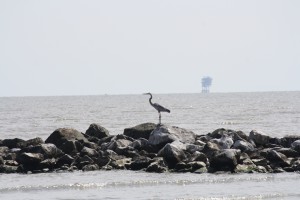
Heron on a breakwater
When we talk about the success of a restoration project, what exactly are we measuring? Well, scientists and the public aren’t always looking at the same characteristics, and that can make this process really complicated. First of all, there is the physical structure of the area- we can see when sediment is added to a beach to combat erosion or when a terrace of rocks and sediment is constructed to create new habitat for marsh grass. Based on that criterion, as long as the beach or new platform is still there, the project has been a success. But there is so much more to restoring an ecosystem- which plants colonize the area, and which animals? How do they interact? Have any invasive species appeared? Is the beach or marsh platform fulfilling its ecological roles? Will it be able to do so into the future? So measuring the true success of a restoration project requires patience, because you will be waiting years (and even decades) to really understand if it worked. Why is this important? Well, maybe you haven’t noticed, but humans aren’t always good at waiting for things- we want results and we wanted them yesterday. Convincing people to give a restoration project the time and attention it needs to go through the full cycle of succession can be a tough sell.
What do we know about the chronology of salt marsh restoration? Scientists have undertaken several long-term studies to better understand how nature gets involved once the digging/construction/etc. is complete. In southern California, Janousek et al. (2007) saw diatoms and cyanobacteria within 2 months of restoration, but it took considerably longer for invertebrate consumers to appear. Once invertebrates do appear, the first colonizer species tend to be opportunists, those that can tolerate a wide variety of conditions and quickly exploit new food sources. In a North Carolina created marsh, after 2 years molluscs and fabricinid polychaetes had become common, but the large burrowing oligochaetes were not (Levin et al. 1996). Those larger burrowing animals are important because they help develop sub-surface structure- they are also more typical of mature marsh systems, so, if they aren’t present, the marsh still has a ways to go. After 3 or 4 years, the plant community in a restored marsh may look like natural marsh, but that’s just the outside- at that point the faunal communities are not complete. To investigate the point at which larger animals (and especially predators) became established in restored marsh communities, Huspeni & Lafferty (2004) looked at trematodes that are snail parasites. The reasoning here was that, since these trematodes need a snail host, a vertebrate host such as fish, and then ingestion by a larger predator such as herons, if the parasite could complete its life cycle in the restored marsh, that must indicate that the faunal community was pretty diverse (and I think this is a brilliant study- the idea that the life cycle of one species can tell you so much about marsh fauna is fantastic!). They found that it took 6 years before trematode species richness had significantly increased over pre-restoration levels. The problem here is that some people might assume, once the fish and birds are back, the marsh is good, but that’s not actually the case. Rozas & Minello (2001) found that created marshes, although supporting more abundant crustaceans and fish than open ponds, were not the functional equivalents of natural marsh 9 years on. And Stagg & Mendelssohn (2010) found that restored marshes were still not functionally equivalent to natural marshes 19 years after sediment had been added. Does that mean these projects aren’t working? Absolutely not- restored areas tend to have more native species and more similar species richness to natural areas than degraded areas do, but it’s a long process and we have to recognize that the restored marsh can’t be treated as natural marsh for quite some time- it may be more sensitive to environmental changes.
What about land-based animals? Well, breeding seabirds certainly appreciate more space, and a study in the Netherlands found that barnacle geese could help disperse the seeds of early successional plants (Chang et al. 2005). European brown hares could be even more effective at dispersing the seeds of mid-successional plants (although seed dispersal by water still takes the cake). And while some restoration projects could help salt marsh animals indirectly (such as increased tidal action which leads to fewer voles which leads to better success for salt marsh harvest mice (Bias & Morrison 2006)), some are specifically focused on the animals themselves- there have been successful translocation efforts for the endangered Lower Keys marsh rabbit (Faulhaber et al. 2006).
So there has been success, but it’s not immediate and we may never get back exactly what we have lost- but at least it’s progress and we are working to restore as much ecosystem function as possible. Although these projects tend to be large, I’m curious to see how individuals can get involved, so that’s what I’ll look into for next time.
Works cited:
Bias, MA and ML Morrison. 2006. Habitat selection of the salt marsh harvest mouse and sympatric rodent species. The Journal of Wildlife Management 70: 732-742.
Chang, ER, Zozaya, EL, Kuijper, DPJ, and JP Bakker. 2005. Seed dispersal by small herbivores and tidal water: are they important filters in the assembly of salt-marsh communities? Functional Ecology 19: 665-673.
Faulhaber, CA, Perry, ND, Silvy, NJ, Lopez, RR, Frank, PA, and MJ Peterson. 2006. Reintroduction of Lower Keys marsh rabbits. Wildlife Society Bulletin 34: 1198-1202.
Huspeni, TC and KD Lafferty. Using larval trematodes that parasitize snails to evaluate a saltmarsh restoration project. Ecological Applications 14: 795-804.
Janousek, CN, Currin, CA, and LA Levin. 2007. Succession of microphytobenthos in a restored coastal wetland. Estuaries and Coasts 30: 265-276.
Levin, LA, Talley, D, and G Thayer. 1996. Succession of macrobenthos in a created salt marsh. Marine Ecology Progress Series 141: 67-82.
Rozas, LP and TJ Minello. 2001. Marsh terracing as a wetland restoration tool for creating fishery habitat. Wetlands 21: 327-341.
Stagg, CL and IA Mendelssohn. 2010. Restoring ecological function to a submerged salt marsh. Restoration Ecology 18: 10-17.

Nesting brown pelicans on Raccoon Island
When I started looking into coastal marsh and barrier island restoration, I had assumed that there would be a veritable ocean of information to wade through- what I hadn’t expected was the diverse nature of coastal issues depending on where you were. A lot of the information I came across focused on coastal areas in the Gulf of Mexico, which works very well for me, but I also found quite a bit for the New England coast as well, and it turns out that both the issues and the strategies are a bit site-specific.
The low-down. The statistics I found for the Louisiana coast were pretty horrifying- we are losing 62 km² of land per year (Lopez 2009) and the associated sea level rise along the Mississippi River deltaic plain is 10 mm per year (Boustany 2010). And that’s just the normal subsidence and erosion rate without catastrophic events- when Hurricanes Katrina and Rita came through in 2005, they removed a further 559 km² in just a few weeks. Why is this important? Well, the loss of barrier islands and coastal salt marshes means that our shores (and us) have effectively become more vulnerable- vulnerable to storms, vulnerable to rising sea levels (which means less land to work with), and vulnerable to changes in hydrology. As we lose marsh and water levels rise, saline environments are able to move ever-further inland- that might seem like a reasonable situation, especially since one of the big concerns is loss of nursery habitat for fish and shellfish in coastal areas- if everything moves inland, no harm, no foul, right? Except that remember people are living in these coastal areas- invading seawater creates problems with wells, less marsh to absorb high water events means more flooding of coastal settlements (a friend of mine ended up with serious brake issues in her car after regular extra-high tides flooded the driveway too many times), and some important species are best suited to brackish, rather than salt, water conditions.
In New England, the issues seemed to be more based around structural changes humans had made- we put in small culverts when constructing roads across tidal marshes, which restrict tidal flow sometimes leading to decreased salinity and increased algae (Konisky et al. 2006). We also created channels to facilitate boat traffic or blocked water movement to meet our needs. The resulting concerns here aren’t so much tied to storm protection or sinking driveways, but changes in nutrient cycling and natural processes that have made coastal areas more vulnerable to invasive species such as Phragmites reeds and less resilient to other changes.
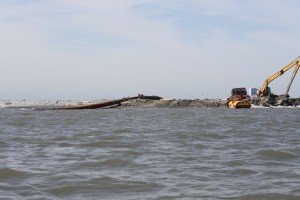
And the island restoration project going on right behind them
How are coastal marshes and barrier islands restored? Often referred to as nourishment (because the idea is that you are providing these areas with the resources they need to survive the conditions they face), there are several different strategies for stopping barrier islands and salt marshes from disappearing. In terms of stopping a barrier island from slipping away in the face of wave and storm action, restoration projects can add sediment to dunes to make them more resilient, to the entire face of the beach from the top of the dunes to below the water line to give the entire beach more depth, and in the form of a ‘feeder bar’ offshore which would continuously feed the beach through wave and storm action (Campbell et al. 2005b). One area of concern has been how high to construct dunes on barrier islands- make them too high and the back of the island won’t be nourished, make them too low and they won’t absorb as much storm energy. You can also add sediment directly to salt marsh areas to counteract subsidence and even create new marsh areas through terrace/platform construction which can be planted with vegetation (Campbell et al. 2005a). Rozas et al. (2005) recommend that irregularly shaped islands be the goal with any of these strategies because crustaceans, such as shrimp and crabs, tend to congregate along marsh edges- the longer the shoreline, the more marsh edge there is.
Aside from nourishment, breakwaters and revetments can absorb and/or redirect wave action and erosion along the coast, and breaches and inlet closures can help recreate historical configurations of islands and marsh, if that is the goal (Campbell et al. 2005b)- although it’s important to remember that coastal change is a continuing process and there is no way to fully stop sediment loss (Landers 2007). To restore tidal flow, larger culverts can be installed and tidal channels can be excavated (Konisky et al. 2006).
Do these methods work? I think that’s the big question in many ways, especially since some of these projects are large-scale and expensive. We know that it is possible to add sediment to islands and marshes, but that doesn’t mean that you are restoring ecosystem function- these could be very compromised systems. Rozas et al. (2005) recommended marsh terracing as the most cost-effective method for restoring marshes and the crustacean fisheries associated with them, but that doesn’t mean that the end result is fully-functioning marsh. For next week I’ll see what I can dig up about success (or lack thereof) in coastal restoration projects- I’ll also try to find studies that expand beyond sediment and shrimp to get a better sense of what restoration means for other creatures.
Works cited:
Boustany, RG. 2010. Estimating the benefits of freshwater introduction into coastal wetland ecosystems in Louisiana: nutrient and sediment analysis. Ecological Restoration 28: 160-174.
Campbell, T., Benedet, L., and CW. Finkl. 2005a. Regional strategies for coastal restoration along Louisiana barrier islands. Journal of Coastal Research 44: 245-267.
Campbell, T., Benedet, L., and G. Thomson. 2005b. Design considerations for barrier island nourishments and coastal structures for coastal restoration in Louisiana. Journal of Coastal Research 44: 186-202.
Konisky, RA., Burdick, DM., Dionne, M., and HA. Neckles. 2006. A regional assessment of salt marsh restoration and monitoring in the Gulf of Maine. Restoration Ecology 14: 516-525.
Landers, J. 2007. Construction nears end on Louisiana coastal restoration project. Civil Engineering February: 22-23.
Lopez, JA. 2009. The multiple lines of defense strategy to sustain coastal Louisiana. Journal of Coastal Research 54: 186-197.
Rozas, LP., Caldwell, P., and TJ. Minello. 2005. The fishery value of salt marsh restoration projects. Journal of Coastal Research 40: 37-50.
 Where I am in Louisiana, when it rains there are standing puddles for a few days- the terrain is pretty flat and a short drive will take me to the coast. Consequently, flooding from extreme weather (such as hurricanes) is always a concern. At the same time this is a very productive environment- we’re currently in the middle of crawfish season (yay!), the farmer’s markets have lots of local produce, and I’m really looking forward to watching flocks of migrant birds pass through on their way north. But how to balance the positives of living here with the dangers?
Where I am in Louisiana, when it rains there are standing puddles for a few days- the terrain is pretty flat and a short drive will take me to the coast. Consequently, flooding from extreme weather (such as hurricanes) is always a concern. At the same time this is a very productive environment- we’re currently in the middle of crawfish season (yay!), the farmer’s markets have lots of local produce, and I’m really looking forward to watching flocks of migrant birds pass through on their way north. But how to balance the positives of living here with the dangers?
One of the things that allowed early settlers to survive hurricanes was that they rarely took a direct hit from a storm’s first landfall- the gulf barrier islands and coastal marshes in south Louisiana absorbed some storm energy and precipitation and thus dampened the ferocity of the onslaught. Unfortunately those islands and marshes are all but gone at this point. While channeling of the Mississippi River has allowed better navigation and reduced flooding of communities along the river itself, by restricting where the water can go, we’ve also restricted the access of coastal marshes and barrier islands to the sediment they need to keep going in the face of wave and storm action, and so we’re losing them piece by piece. This is a problem not only for those of us who live in hurricane-prone areas, but also for the wildlife that uses salt marshes and the surrounding areas, for example breeding brown pelicans.
I know that there are coastal restoration projects here in Louisiana, but I’m not that familiar with the processes involved and their success rate. I have done some research on remediation for salt marshes after exposure to oil spills, but that focused on specific actions for clean-up and supporting ecosystem communities while they deal with the pollution. So this month I’ll be looking at the different methods for restoring coastal marshes and barrier islands, and the results we have seen so far from these types of projects. This topic could cover a wide range of goals and associated actions, and I’m hopeful that I can find ways to get directly involved in the work.
For me, the integrity of coastal wetlands is something of an important issue based on where I’m living and what weather I expect to see this summer, but people and wildlife in other areas have just as many pressing reasons to value their coastal wetlands, and I hope that the information I dig up in my search can apply to areas outside of Louisiana.














